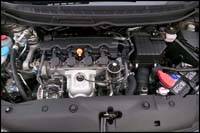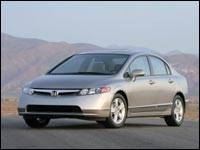The 2006 sedan continues forward with such lofty targets in mind, but brings back to the category a few performance-oriented personality traits,
 |
| The new car's acceleration is a great deal brisker off the line, andfully capable of safely executing a pass on the highway. (Photo: Honda) |
such as spirited acceleration, nimble handling, and a driver-centric cockpit, all features which used to be core Honda values.
First on the menu is a larger, improved engine, now a 1.8-litre four-cylinder instead of a 1.7, making 140-horsepower at 6,300 rpm in base trim, compared to 115- or 127-horsepower at 6,100 and 6,300 rpm respectively, in base or previous Si or EX trim, and 128 lb-ft of torque at 4,300 rpm, an improvement from 110 lb-ft of torque at 4,500 rpm or 114 at 4,800 rpm, respectively. This means the new car's acceleration is a great deal brisker off the line, and fully capable of safely executing a pass on the highway. As important, and maybe more so this day and age, while the new car gets up and goes with the best of them it doesn't do so at the expense of fuel economy. I agree with Honda saying its 1.8 has equivalent power to a 2.0-litre engine, yet only sips away at fuel like a 1.5 - the Civic's estimated city/highway rating of 7.8 / 5.7 L/100 km with a manual transmission is extremely good - the autobox taxes the engine a little more and therefore causes fuel economy to drop to 8.2 L/100 km in
 |
| The Civic's estimated city/highway rating of 7.8 / 5.7 L/100 km with a manual transmission is extremely good. (Photo: Honda) |
the city, although its tall final drive means highway consumption is identical to the manual. Also, emissions have been lowered, now with a rating of ULEV-2 compared to ULEV-1.
All this power, combined with low emissions and reduced fuel economy comes from Honda's latest generation technology. The 1.8 features the newest version of VTEC, now sporting an "
i" in front of the acronym for
i-VTEC
intelligent valve control system. Why does Honda refer to it as
intelligent? Because it uses new valve control timing to reduce pumping losses when cruising and other low engine load situations. If the variable valve timing briefly leaves an intake valve open just as the piston begins its compression stroke, pumping losses are minimized. Basically, more unburned air/fuel mixture ignites during this process, yielding higher performance and reduced fuel consumption. The engine also utilizes a dedicated set of cams for closing one of the intake valves, and by so doing retard its timing, which adds backpressure to the air/fuel mixture. While this chokes off intake air, the throttle is opened wider to enhance engine output. Again, the best of both worlds. There's a lot more to this engine than I have column space or time to go into, so suffice it to say Honda's new 1.8 is the class leader in technology and among the most efficient anywhere.




